Star Cluster Formation from Molecular Clouds
Stars are born in “molecular clouds,” which are low-temperature clouds of gas composed almost entirely of hydrogen molecules. It is believed that many stars are born at the same time and form star clusters. During the formation of a star cluster, massive stars ionize the surrounding molecular clouds, creating a bubble of hot gas called an ionized region. As the cluster formation progresses and the number of massive stars increases, all of the molecular clouds in the cluster are blown away by ionization, leaving only stars that are gravitationally bound together. This is known as a star cluster.
This video shows a simulation of the star cluster formation process by combining hydrodynamics calculations of a molecular cloud collapsing under gravity and calculations of the orbits of the stars born in the cloud as they move under the influence of the gravity from the molecular cloud and other stars.
 |
Denser areas in the molecular cloud gradually increases as they attract surrounding gas with their gravity. |
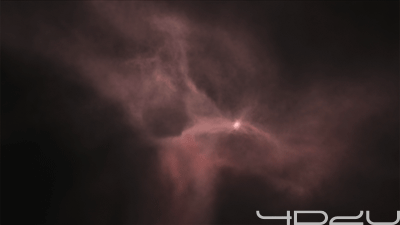 |
Stars are born where molecular clouds gather and become dense. When a massive star is born, its light (the dimly glowing white area to the lower right of the center) warms the surrounding gas. At this time, the newborn stars are still buried in the molecular cloud. |
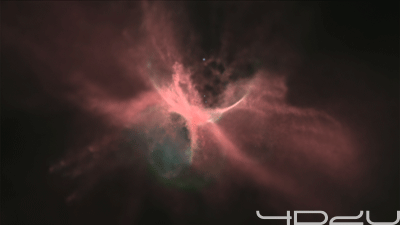 |
As star formation progresses, multiple stars are born. Stars that are strongly scattered by gravity are ejected from the dense part of the molecular cloud to the thin outer part. The ejected massive stars ionize the thin molecular cloud, creating an ionized region (green) filled with hot gas. |
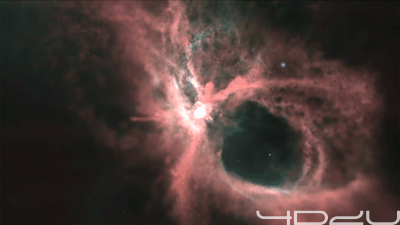 |
Let's stop and take a closer look at the forming cluster. |
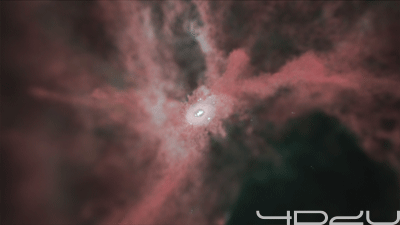 |
The center of the cluster is still half buried in the molecular cloud, but at the center the molecular cloud is ionized and appears to have a hole in it. Star formation continues in the molecular cloud surrounding the hole. The Orion Nebula and the star clusters within it are thought to be in this stage. |
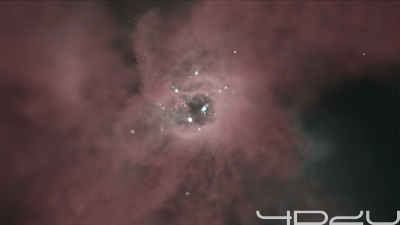 |
Here we move forward in time again. In a star cluster that is just forming, gravitationally bound stars are moving around. When several stars approach each other, they are accelerated by each other's gravity, and some stars may fly out of the cluster. |
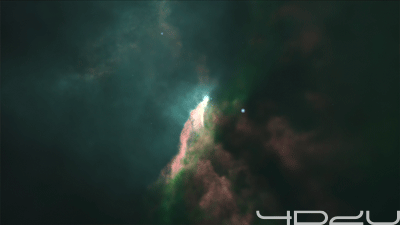 |
As star formation progresses, there is more ionized hot gas (green) than cold molecular clouds (red). |
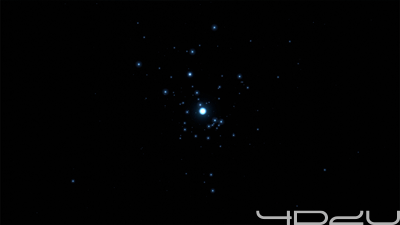 |
Finally, all molecular clouds in the cluster have been ionized and lost, leaving only gravitationally bound stars. This is a diffuse cluster, such as the Pleiades cluster. |
Details of Numerical Simulation
| Purpose | To elucidate the formation process of open clusters and understand still forming open clusters such as the Orion Nebula. |
| Methods and Models | N-body/SPH simulations, star formation, radiative cooling, heating by radiation from massive stars |
| Number of Particles | 2 x 106 particles (gas), up to about 104 particles (stars) |
| Computer | Cray XC50 "ATERUI II" (CfCA, NAOJ) |
| Time Scale | About 10 Myr |
| Spatial Scale | About 10 pc |
| Resercher | Michiko Fujii (The University of Tokyo) |
| References | SIRIUS Project - IV. The formation history of the Orion Nebula Cluster driven by clump mergers SIRIUS Project - V. Formation of off-centre ionized bubbles associated with Orion Nebula Cluster |
Details of Visualization
This movie shows the motion of two types of particles, representing stars and gas. Several previous 4D2U videos have also shown the motion of gas particles. This movie is the first time we tried calculating the shadows the gas throws on itself. We use particularly bright (heavy) stars as light sources, which illuminate the gas cloud from the inside, adding the effect of shadows falling on the gas cloud itself. Rendering shadows on gaseous objects is very computationally intensive, so it is not possible to treat all the stars as light sources. In this case, only some bright stars have been selected as light sources. Thanks to the effects of the light source and the shadows of the gas, the image has a more three-dimensional appearance.
Credits
- Simulation: Michiko Fujii
- Visualization: Takaaki Takeda
- Four-Dimensional Digital Universe Project, NAOJ
VR on YouTube
- Non-stereo VR
Web Browsers: You can aim the movie point-of-view in any direction you prefer by dragging the mouse over the YouTube screen.
Smartphones and Tablets: Using the YouTube App (iOS, Android), all directions can be seen by facing your device in the chosen direction. With VR viewers, you can enjoy the full effect of stereoscopic vision in all directions.
※Please note that there are some cases in which this video cannot be watched depending on your environment.
Information
- 2025.4 Version 1.0 was released.

720p, Long version
StarCluster_long_720p_mp4.zip (.mp4 (H.264), zip file : 210 MB)
StarCluster_long_720p_wmv.zip (.wmv, zip file : 84 MB)
720p, Short version
StarCluster_short_720p_mp4.zip (.mp4 (H.264), zip file : 127 MB)
StarCluster_short_720p_wmv.zip (.wmv, zip file : 50 MB)
1080p, Long version
StarCluster_long_1080p_mp4.zip (.mp4 (H.264), zip file : 421 MB)
StarCluster_long_1080p_wmv.zip (.wmv, zip file : 155 MB)
Side-by-Side Stereovision, 1080p, Long version
StarCluster_long_1080p_SBS_mp4.zip (.mp4 (H.264), zip file : 420 MB)
StarCluster_long_1080p_SBS_wmv.zip (.wmv, zip file : 152 MB)
1080p, Short version
StarCluster_short_1080p_mp4.zip (.mp4 (H.264), zip file : 527 MB)
StarCluster_short_1080p_wmv.zip (.wmv, zip file : 99 MB)
Side-by-Side Stereovision, 1080p, Short version
StarCluster_1080p_short_SBS_mp4.zip (.mp4 (H.264), zip file : 257 MB)
StarCluster_short_1080p_SBS_wmv.zip (.wmv, zip file : 95 MB)
Panoramic Video for VR
StarCluster_long_VR_SBS_mp4.zip (Stereovision with Side-by-Side, .mp4, zip file : 1 GB)
StarCluster_long_VR_TAB_mp4.zip (Stereovision with Top-and-Bottom, .mp4, zip file : 3 GB)
StarCluster_long_VR_mp4.zip (Non-Stereo, .wmv, zip file : 1 GB)
Other file formats
- 1080p GoPro CineForm (files for right and left eyes, .mov)
- 2048x2048 Stereo/Non-Stereo Dome Master (.mp4, .jpg sequence files)
- 4096x4096 Stereo/Non-Stereo Dome Master (.mp4, .jpg sequence files)
If you want to use these file formats, please contact us.